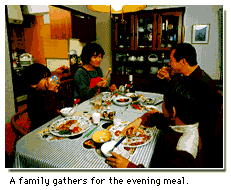 |
 The Japanese lifestyle underwent a major transformation following World War II. The traditional Japanese house was detached and made of wood with tiled roofs, and almost all rooms had tatami-mat floors. Today's home usually has Western-style rooms with wooden flooring and is often constructed with steel pillars. The Japanese lifestyle underwent a major transformation following World War II. The traditional Japanese house was detached and made of wood with tiled roofs, and almost all rooms had tatami-mat floors. Today's home usually has Western-style rooms with wooden flooring and is often constructed with steel pillars.
An increasing number of families in urban areas, moreover, are living in large, ferroconcrete apartment buildings. The Japanese home's biggest differences with Western dwellings are that shoes are not worn inside the house and that at least one room tends to be in Japanese style with a tatami floor. |
 The staple food of
the traditional Japanese diet is rice,
with meals being eaten with chopsticks. A substantial share of what the
Japanese eat today, however, are dishes from other countries, notably
those in Europe, North America, and Asia. The Japanese diet is surprisingly
diversified. In addition to rice, Japanese like bread and noodles and
enjoy a wide array of meats, fishes, vegetables, and fruits. The staple food of
the traditional Japanese diet is rice,
with meals being eaten with chopsticks. A substantial share of what the
Japanese eat today, however, are dishes from other countries, notably
those in Europe, North America, and Asia. The Japanese diet is surprisingly
diversified. In addition to rice, Japanese like bread and noodles and
enjoy a wide array of meats, fishes, vegetables, and fruits.
There are also many fast-food restaurants selling hamburgers and fried chicken that are especially popular with young people and children. |
| Although Japan's traditional dress is the kimono, it is
now usually worn only on special occasions, such as weddings and during
New Year.
The younger generation prefers clothing that is easier to move around
in, like T-shirts, jeans, polo shirts, and sweat suits.
Photos courtesy of Ministry of Foreign Affairs and Tokyo Metropolitan Government. |

